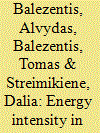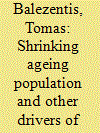|
|
|
Sort Order |
|
|
|
Items / Page
|
|
|
|
|
|
|
| Srl | Item |
| 1 |
ID:
110425


|
|
|
|
|
| Publication |
2011.
|
| Summary/Abstract |
The measurement, assessment, and effective mitigation of energy intensity compose a foremost objective of contemporary energy policy. Although the European Union (EU) Member States have been experiencing the convergence in energy efficiency indicators, Lithuania, acceded to the EU in 2004, still remains peculiar with relatively high energy intensity. Our study, therefore, is aimed at analyzing the energy intensity trends in Lithuanian economy as a whole as well as in separate economic sectors. The investigation covers the period of 1995-2009. The Logarithmic Mean Divisia Index was applied for decomposition analysis. Our analysis has shown that energy efficiency falls during economic downturn. In order to facilitate these challenges the Lithuanian Government as well as business should opt for increasing energy efficiency in the most problematic sectors of transport and services. In addition, the analysis of legal acts, namely National Energy Efficiency Programme for 2006-2010 and Energy Efficiency Action plan for 2010-2016, was taken into consideration. Some suggestions, thus, were offered for successful implementation of strategic goals outlined in the aforementioned strategic documents.
|
|
|
|
|
|
|
|
|
|
|
|
|
|
|
|
| 2 |
ID:
116753


|
|
|
|
|
| Publication |
2012.
|
| Summary/Abstract |
Lithuania has developed several important climate change mitigation policy documents however there are no attempts in Lithuania to develop local climate change mitigation policies or to decentralize climate change mitigation policy. Seeking to achieve harmonization and decentralization of climate change mitigation and energy policies in Lithuania the framework for local climate change mitigation strategy need to be developed taking into account requirements, targets and measures set in national climate change mitigation and energy policy documents.
The paper will describe how national climate change mitigation and energy policies can be implemented via local energy and climate change mitigation plans.
The aim of the paper is to analyze the climate change mitigation policy and its relationship with policies promoting sustainable energy development in Lithuania and to present a framework for local approaches to climate change mitigation in Lithuania, in the context of the existing national and supra-national energy, climate change, and rural development policies.
|
|
|
|
|
|
|
|
|
|
|
|
|
|
|
|
| 3 |
ID:
176750


|
|
|
|
|
| Summary/Abstract |
Energy use and the resulting environmental impacts are interrelated with socioeconomic development of a certain region. What is more, the residential sector plays an important role as a major consumer of the energy. Thus, it is important to identify the underlying patterns of energy consumption and the resulting CO2 emission amidst the external shocks. This paper focuses on the case of residential energy consumption and CO2 emission in Lithuania over 2004–2016. This example is important given the context of shifts in the size and structure of population, economy and energy transformation in Lithuania that occurred over the period covered. The analysis relies on the index decomposition analysis and factorizes the changes in CO2 emission into the effects of population size, household size, dwelling area, energy intensity and carbon factor. The results indicate that decline in energy intensity and population played the most important role in pushing the CO2 emission down, yet these effects were offset by the changes in the lifestyle of the population (i.e. household size and dwelling area) along with increasing carbon factor. These findings are contrasted to the corresponding findings form the earlier studies around the world and the resulting policy implications are delivered.
|
|
|
|
|
|
|
|
|
|
|
|
|
|
|
|
|
|
|
|
|